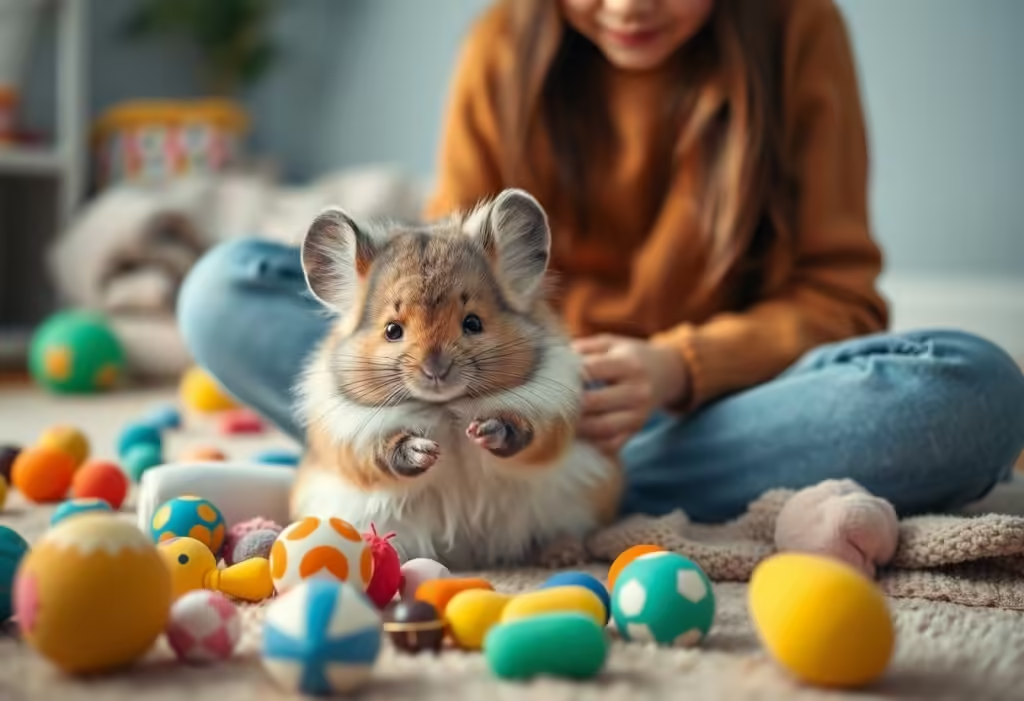Chinchillas are active, intelligent creatures that need regular mental and physical stimulation. To play with your chinchilla, use interactive toys like tunnels and climbing structures in a safe, supervised environment. This keeps them entertained and strengthens your bond. Creating a safe, engaging play area will ensure they stay happy and healthy.
Key Takeaways:
- Engage natural instincts: Use tunnels, chew toys, and safe climbing structures to engage your chinchilla.
- Ensure safety: Remove hazards like electrical cords and small objects from the play area.
- Handle gently: Always handle your chinchilla with care to avoid stress.
- Supervise exploration: Allow space for your chinchilla to hop, climb, and explore while monitoring their activity.

Understanding Chinchilla Behavior
Chinchillas are curious and love to explore. Their social nature thrives on interaction, making playtime essential for their well-being. By understanding their behavior, you can make playtime more enriching and enjoyable.
- Social Needs: Chinchillas benefit from interactive play and companionship.
- Playful Nature: They enjoy jumping, climbing, and exploring new environments and toys.
Creating a Safe Play Environment
To ensure your chinchilla’s safety during playtime, remove hazards like electrical cords and small objects. A chin-proofed area is vital for safe play. Block off any potential escape routes and remove anything that could pose a danger.
Tips for a Safe Play Area:
- Remove electrical cords to prevent chewing.
- Block access to unsafe furniture or small spaces.
- Provide soft surfaces, like blankets or mats, to cushion their jumps.
Hazards to Avoid:
- Small objects: Avoid items like batteries or small toys that can be swallowed.
- Toxic plants or chemicals: Remove any plants or objects treated with pesticides.
- Unsecured furniture: Ensure no furniture poses a risk of falling.
Types of Play Activities
Incorporating a variety of activities keeps your chinchilla mentally and physically engaged. Here are four types of play activities that will help provide the necessary stimulation.
| Play Activity | Description |
|---|---|
| Tunnel Games | Running through tunnels and playing hide and seek. |
| Chew Toys | Safe, chewable items to maintain dental health. |
| Climbing Structures | Ramps or platforms to encourage jumping and climbing. |
| Dust Baths | Essential for keeping their fur clean and healthy. |

Bonding with Your Chinchilla
Building trust is essential for bonding with your chinchilla. Be patient, handle them gently, and use positive reinforcement, like treats, to encourage interaction. This helps create a safe, comfortable environment where your chinchilla enjoys playing with you.
Signs of Enjoyment:
- Leaping and exploring: Your chinchilla feels happy and safe.
- Soft vocalizations: Chirps or purring indicate comfort.
Recognizing Stress:
- Hiding or aggression: Your chinchilla may be overwhelmed or scared.
- Excessive grooming: This can signal stress or discomfort.
Final Words
Playing with your chinchilla is a great way to strengthen your bond and provide the mental and physical stimulation they need. By creating a safe, engaging environment with varied activities, you’ll ensure your chinchilla stays happy, active, and entertained.
FAQ
Q: What are the best toys for playing with a chinchilla?
A: Safe toys include wooden chew toys, tunnels, and climbing structures. Always choose non-toxic, chew-safe materials.
Q: How can I encourage my chinchilla to play?
A: Create a safe play area with tunnels and ramps, and use treats to encourage exploration and play.
Q: Can I take my chinchilla outside to play?
A: You can take your chinchilla outside, if it’s in a secure, enclosed area. Ensure the area is cool and shaded, and monitor them closely to avoid escape or injury.
Q: How often should I play with my chinchilla?
A: Aim for 30 minutes to an hour of playtime each day, depending on your chinchilla’s activity levels.
Q: Are there any games that chinchillas enjoy?
A: Chinchillas enjoy obstacle courses, foraging games like treat-hiding, and interactive toys such as treat-dispensing balls.
